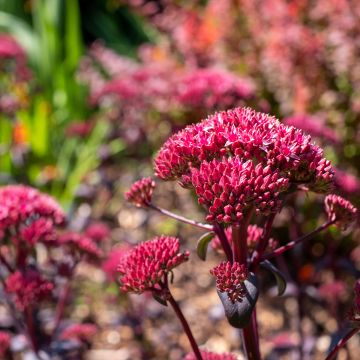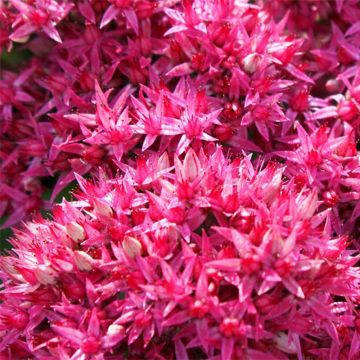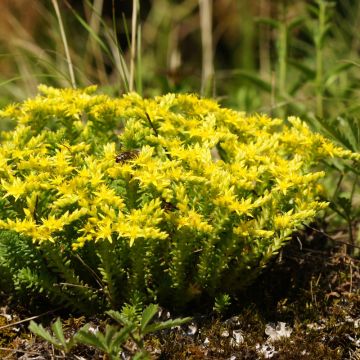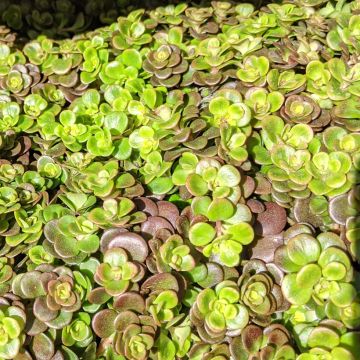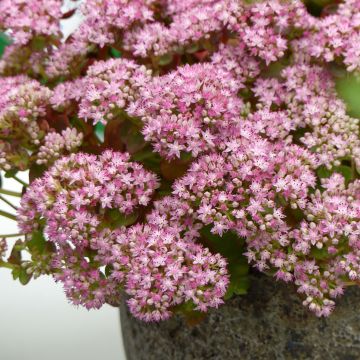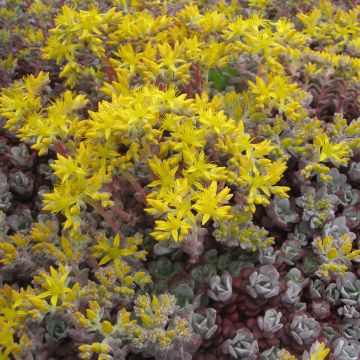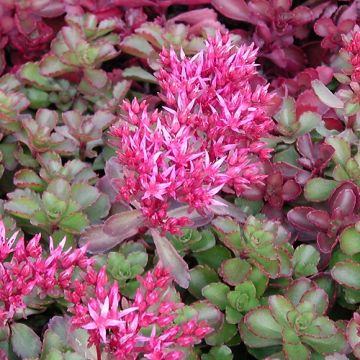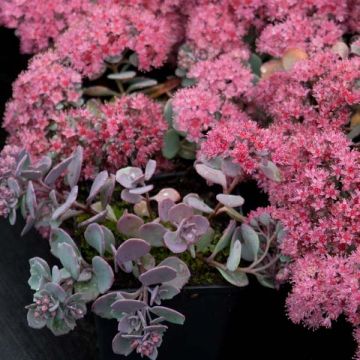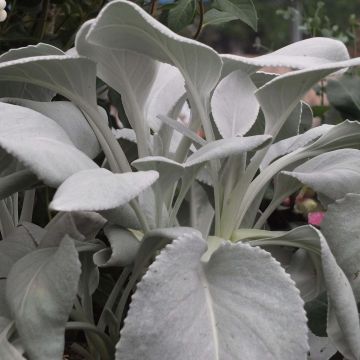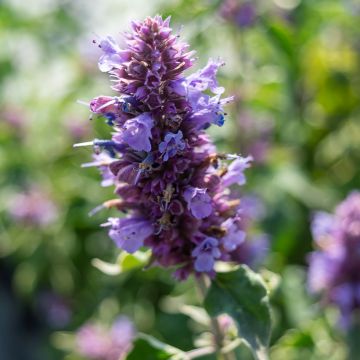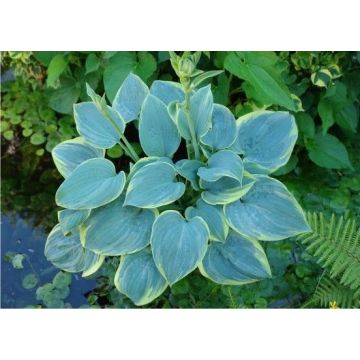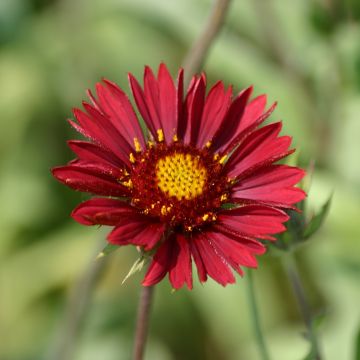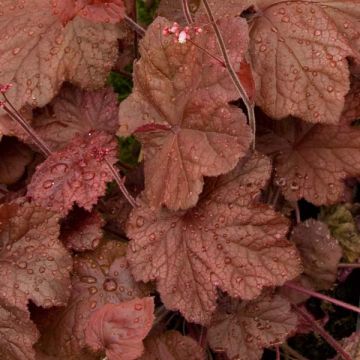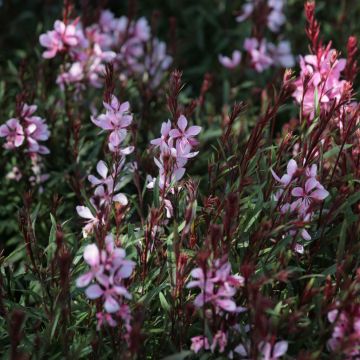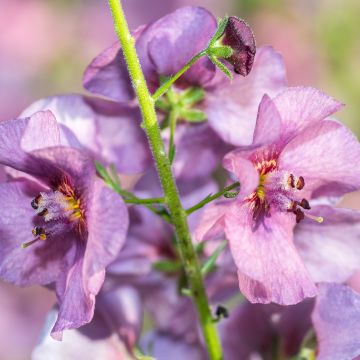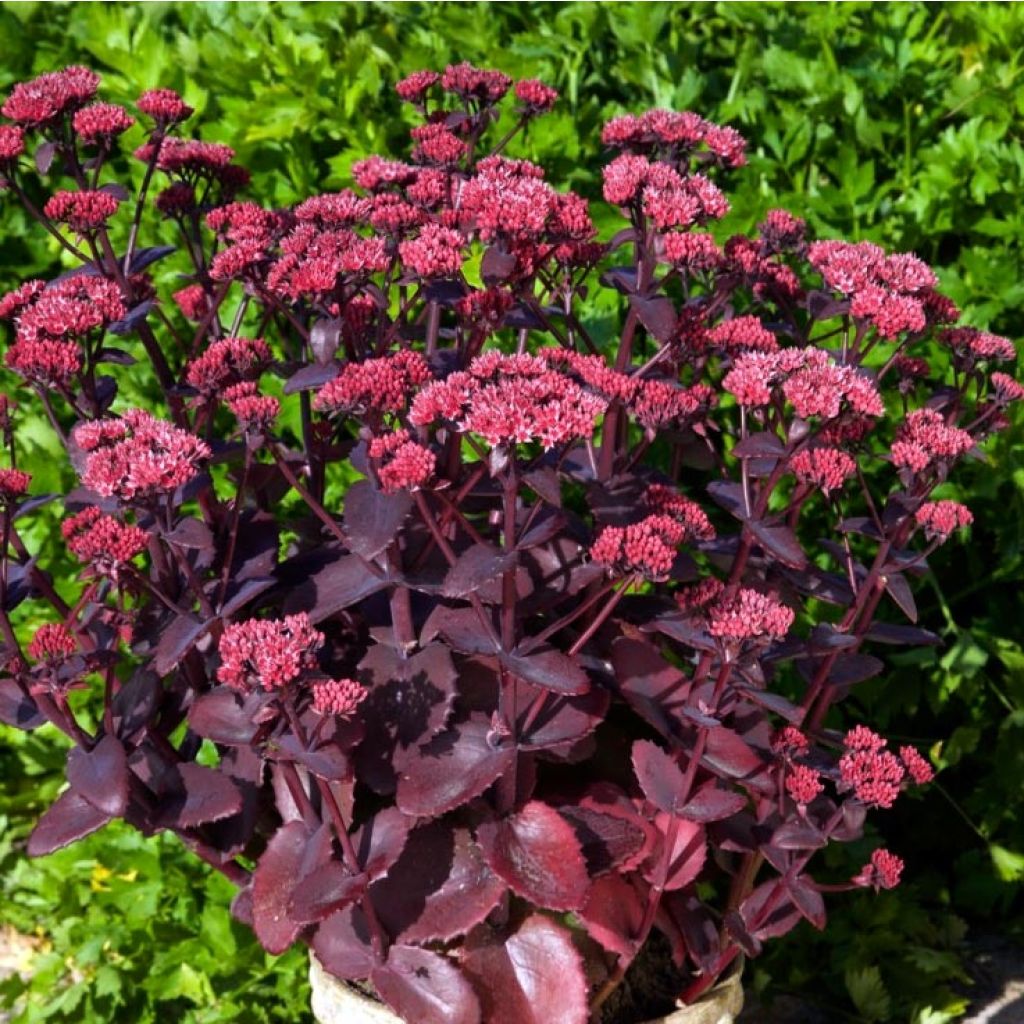

Sedum Chocolate Cherry - Orpin reprise.
Sedum telephium Chocolate Cherry - Autumn Stonecrop
Sedum telephium Chocolate Cherry
Autumn Stonecrop, Orpin, Livelong, Frog's-stomach, Harping Johnny, Life-everlasting, Live-forever, Midsummer-men, Orphan John, Witch's Moneybags
This item cannot be shipped to the selected country
Delivery charge from €5.90
Delivery charge from €5.90
Delivery charge from €5.90
More information
Schedule delivery date,
and select date in basket
This plant carries a 12 months recovery warranty
More information
We guarantee the quality of our plants for a full growing cycle, and will replace at our expense any plant that fails to recover under normal climatic and planting conditions.
From €5.90 for pickup delivery and €6.90 for home delivery
Express home delivery from €8.90.
From €5.90 for pickup delivery and €6.90 for home delivery
Express home delivery from €8.90.
From €5.90 for pickup delivery and €6.90 for home delivery
Express home delivery from €8.90.
Does this plant fit my garden?
Set up your Plantfit profile →
Description
Sedum 'Chocolate Cherry' is a new cultivar of a robust perennial plant with succulent foliage, also known as orpine reprise. This variety stands out for its compact habit, disease resistance, and its dark and rich colours. It forms a remarkable harmony between the foliage and the flowering. Its dark purple foliage with purple to chocolate reflections bears clusters of purple flower buds, which open into dark red star-shaped flowers. The spectacle takes place from July to September, animating sunny flower beds, rockeries, borders, and patios.
Sedum telephium (synonyms Hylotelephium telephium, S. purpurascens) is a robust perennial plant from the Crassulaceae family. It is native to central Europe, especially the Caucasus, the Bithynia region in Turkey, and Siberia. It has naturalised in many regions where it can be found growing among rocks, at the base of hedges, and in the understory. It is an almost indestructible plant, capable of tolerating shade, moist or dry soils.
The 'Chocolate Cherry' cultivar, bred in the Netherlands by Marco Van Noort, has recently been introduced to the horticultural market. This plant, which disappears in winter, forms a bushy and upright clump from spring to autumn, spreading up to 40cm (16in), composed of sturdy purple stems that rise up to 30cm (12in) from the ground. They bear oval, thick, glabrous, flat leaves that are arranged alternately and are sessile (without petioles). This deciduous foliage displays remarkable shades: dark purple-violet with brown reflections and occasionally some green reflections These nuances vary, like most of its relatives in the same genus, depending on climatic conditions, and the amount of light and water received. Its long-lasting flowering consists of generous dense corymbs, almost flat-topped, composed of multiple dark red flower buds that open into small star-shaped red flowers, highly valued by pollinating insects.
Orpines are proof that poor soil can grow beautiful specimens with generous flowering. You can still benefit from hardy perennials if your soil is poor, rather dry, even rocky or slightly chalky. They withstand temperatures below -15°C (5°F), require no maintenance, and promise to enliven the garden with a constant flutter of butterflies. These succulents are easy-going and offer flowers and foliage in various shades to create dazzling displays in flower beds or containers.
Sedum 'Chocolate Cherry' offers a palette of sumptuous shades that allow for multiple associations. The trend is for combinations of purples and golds: for example, pair it with goldenrod, solidago, Sedum acre (very invasive), or heucheras with golden or amber foliage. Blue flowers enhance brown and purple shades: plant 'Chocolate Cherry' in a perennial flax sowing, alongside wild chicory or perennial geraniums like 'Blue Cloud' or 'Rozanne'. Pink flowers of certain yarrows ('Love Parade', 'Cerise Queen'), and Coreopsis 'Limerock Passion' also go well with purple sedums. In a natural setting, combine it, for example, with grasses such as stipa, muhlenbergia, panicum, certain sedges, and plants with grey foliage that often tolerate the same difficult living conditions. You can create an unforgettable scene by pairing it with autumn asters ('Vasterival', 'Calliope', A. turbinellus), or magellan fuchsias. Magnificent in a pot, it is also an excellent flower for drying or for fresh bouquets.
Report an error about the product description
Sedum telephium Chocolate Cherry - Autumn Stonecrop in pictures
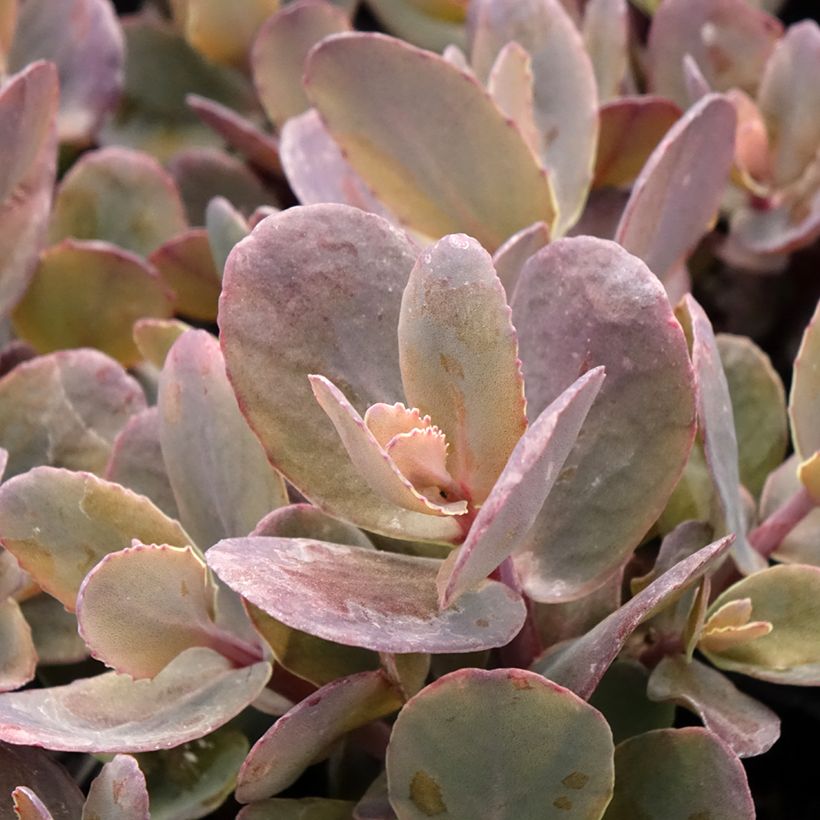

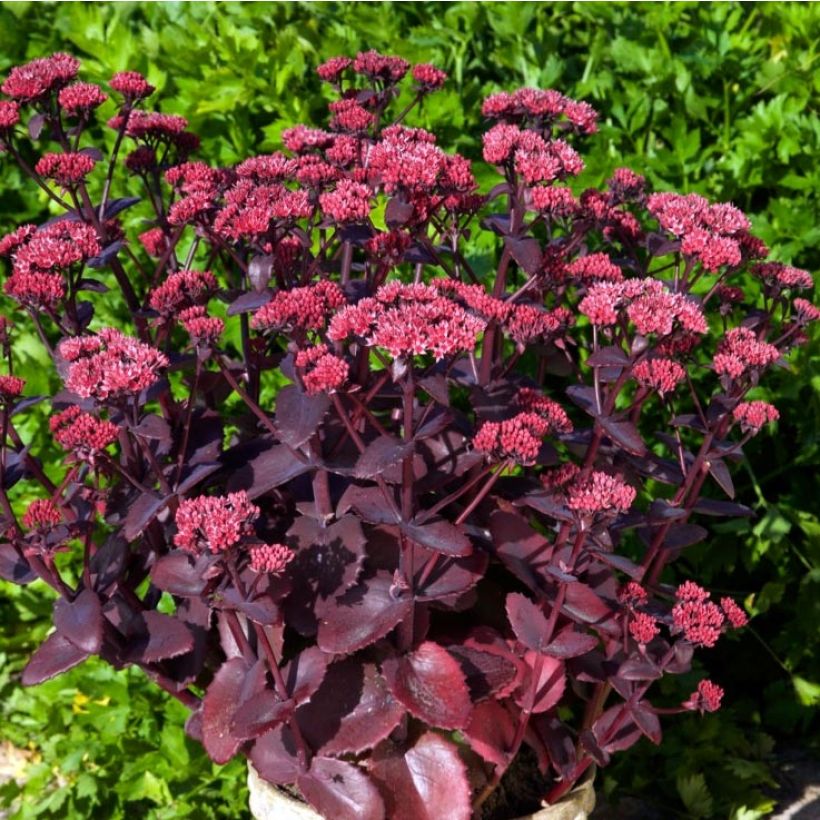

Flowering
Foliage
Plant habit
Botanical data
Sedum
telephium
Chocolate Cherry
Crassulaceae
Autumn Stonecrop, Orpin, Livelong, Frog's-stomach, Harping Johnny, Life-everlasting, Live-forever, Midsummer-men, Orphan John, Witch's Moneybags
Cultivar or hybrid
Other Sedum
Planting and care
Plant Sedum 'Chocolate Cherry' in spring or autumn in well-drained, even rocky, and sunny soil. It also tolerates heavy and slightly chalky substrates. However, add gravel to the planting hole if your soil is moist or tends to retain some moisture in winter. Take the same precautions if you want to place it in a container.
Prune the inflorescences at the end of flowering or at the very beginning of spring if you prefer to keep the dried flowers on the plant for winter decoration. Beware of gastropods that attack the leaves. Divide the stump if the centre begins to thin. Do this approximately every 3-4 years, depending on its growth.
Planting period
Intended location
Care
-
, onOrder confirmed
Reply from on Promesse de fleurs
Summer flowering perennials
Haven't found what you were looking for?
Hardiness is the lowest winter temperature a plant can endure without suffering serious damage or even dying. However, hardiness is affected by location (a sheltered area, such as a patio), protection (winter cover) and soil type (hardiness is improved by well-drained soil).

Photo Sharing Terms & Conditions
In order to encourage gardeners to interact and share their experiences, Promesse de fleurs offers various media enabling content to be uploaded onto its Site - in particular via the ‘Photo sharing’ module.
The User agrees to refrain from:
- Posting any content that is illegal, prejudicial, insulting, racist, inciteful to hatred, revisionist, contrary to public decency, that infringes on privacy or on the privacy rights of third parties, in particular the publicity rights of persons and goods, intellectual property rights, or the right to privacy.
- Submitting content on behalf of a third party;
- Impersonate the identity of a third party and/or publish any personal information about a third party;
In general, the User undertakes to refrain from any unethical behaviour.
All Content (in particular text, comments, files, images, photos, videos, creative works, etc.), which may be subject to property or intellectual property rights, image or other private rights, shall remain the property of the User, subject to the limited rights granted by the terms of the licence granted by Promesse de fleurs as stated below. Users are at liberty to publish or not to publish such Content on the Site, notably via the ‘Photo Sharing’ facility, and accept that this Content shall be made public and freely accessible, notably on the Internet.
Users further acknowledge, undertake to have ,and guarantee that they hold all necessary rights and permissions to publish such material on the Site, in particular with regard to the legislation in force pertaining to any privacy, property, intellectual property, image, or contractual rights, or rights of any other nature. By publishing such Content on the Site, Users acknowledge accepting full liability as publishers of the Content within the meaning of the law, and grant Promesse de fleurs, free of charge, an inclusive, worldwide licence for the said Content for the entire duration of its publication, including all reproduction, representation, up/downloading, displaying, performing, transmission, and storage rights.
Users also grant permission for their name to be linked to the Content and accept that this link may not always be made available.
By engaging in posting material, Users consent to their Content becoming automatically accessible on the Internet, in particular on other sites and/or blogs and/or web pages of the Promesse de fleurs site, including in particular social pages and the Promesse de fleurs catalogue.
Users may secure the removal of entrusted content free of charge by issuing a simple request via our contact form.
The flowering period indicated on our website applies to countries and regions located in USDA zone 8 (France, the United Kingdom, Ireland, the Netherlands, etc.)
It will vary according to where you live:
- In zones 9 to 10 (Italy, Spain, Greece, etc.), flowering will occur about 2 to 4 weeks earlier.
- In zones 6 to 7 (Germany, Poland, Slovenia, and lower mountainous regions), flowering will be delayed by 2 to 3 weeks.
- In zone 5 (Central Europe, Scandinavia), blooming will be delayed by 3 to 5 weeks.
In temperate climates, pruning of spring-flowering shrubs (forsythia, spireas, etc.) should be done just after flowering.
Pruning of summer-flowering shrubs (Indian Lilac, Perovskia, etc.) can be done in winter or spring.
In cold regions as well as with frost-sensitive plants, avoid pruning too early when severe frosts may still occur.
The planting period indicated on our website applies to countries and regions located in USDA zone 8 (France, United Kingdom, Ireland, Netherlands).
It will vary according to where you live:
- In Mediterranean zones (Marseille, Madrid, Milan, etc.), autumn and winter are the best planting periods.
- In continental zones (Strasbourg, Munich, Vienna, etc.), delay planting by 2 to 3 weeks in spring and bring it forward by 2 to 4 weeks in autumn.
- In mountainous regions (the Alps, Pyrenees, Carpathians, etc.), it is best to plant in late spring (May-June) or late summer (August-September).
The harvesting period indicated on our website applies to countries and regions in USDA zone 8 (France, England, Ireland, the Netherlands).
In colder areas (Scandinavia, Poland, Austria...) fruit and vegetable harvests are likely to be delayed by 3-4 weeks.
In warmer areas (Italy, Spain, Greece, etc.), harvesting will probably take place earlier, depending on weather conditions.
The sowing periods indicated on our website apply to countries and regions within USDA Zone 8 (France, UK, Ireland, Netherlands).
In colder areas (Scandinavia, Poland, Austria...), delay any outdoor sowing by 3-4 weeks, or sow under glass.
In warmer climes (Italy, Spain, Greece, etc.), bring outdoor sowing forward by a few weeks.

































